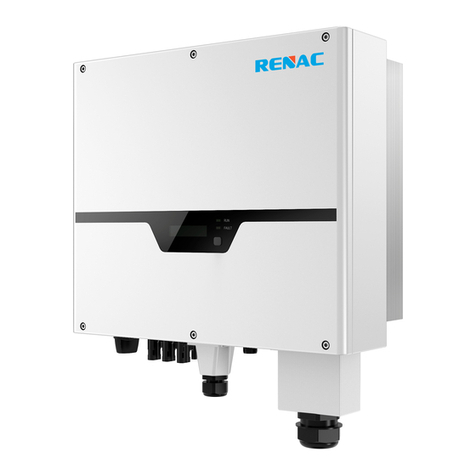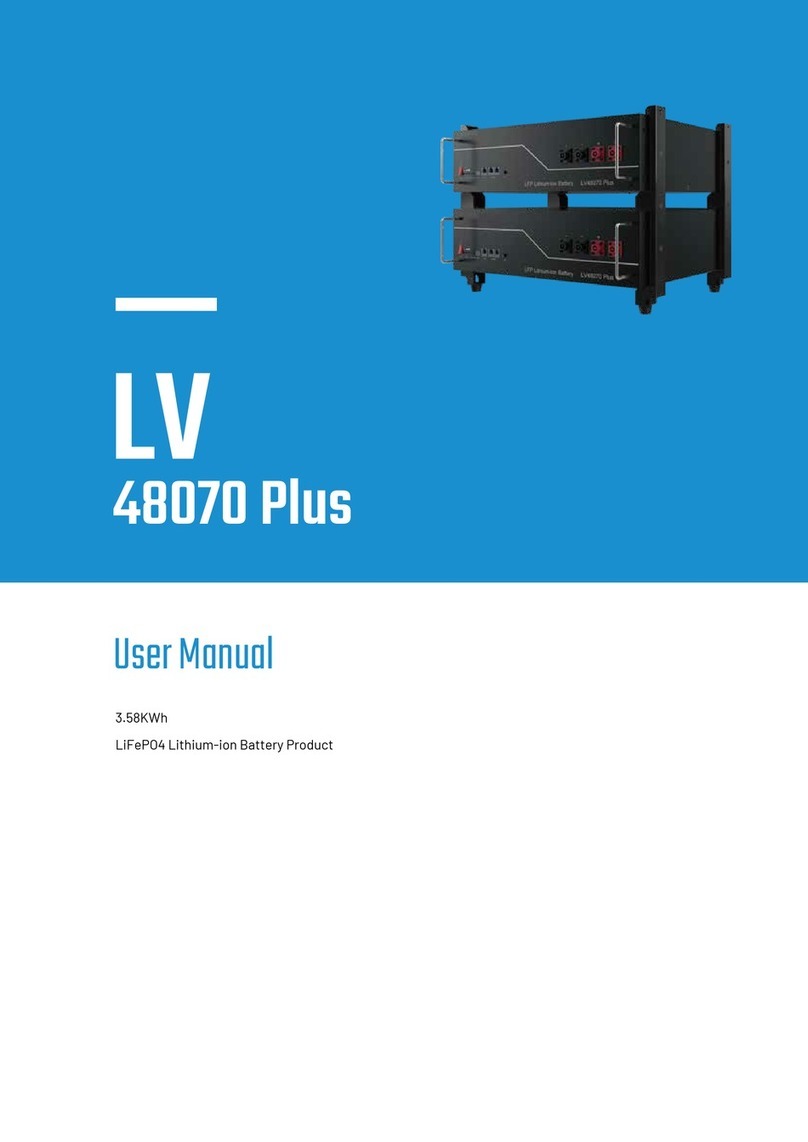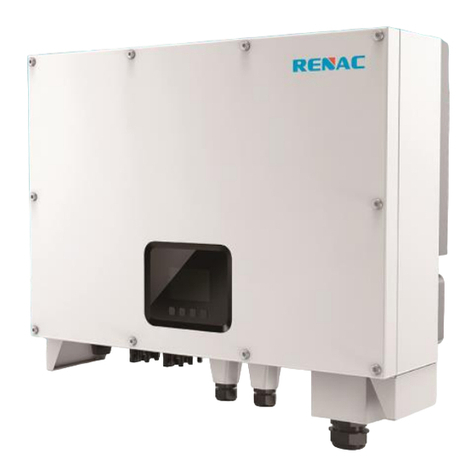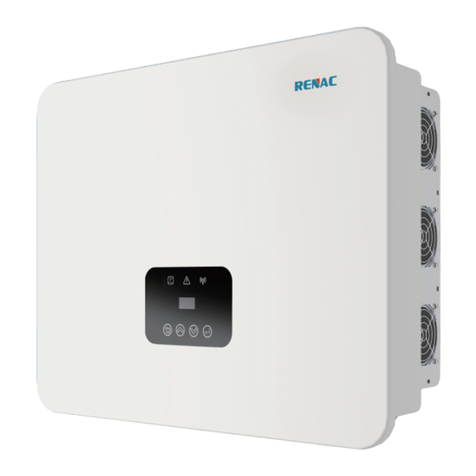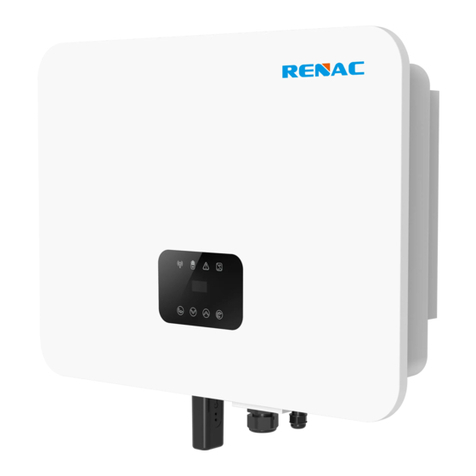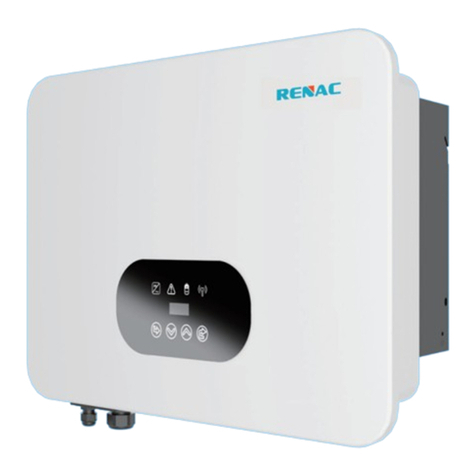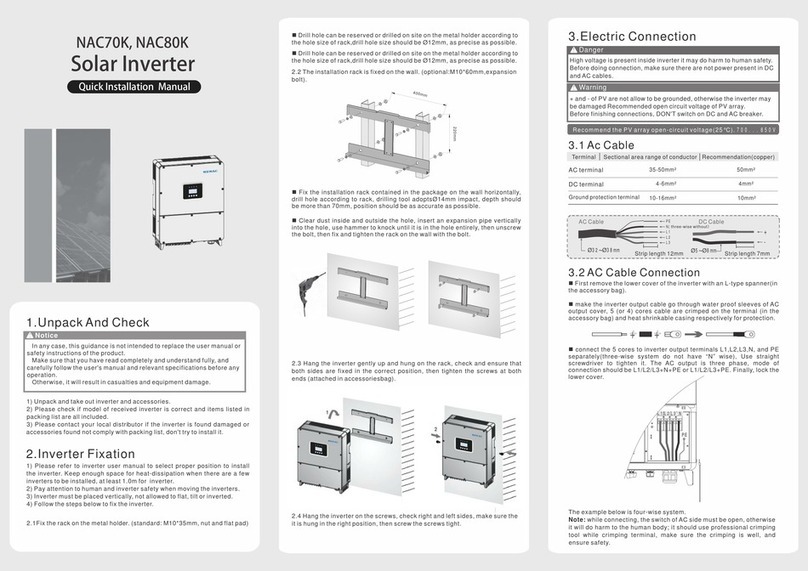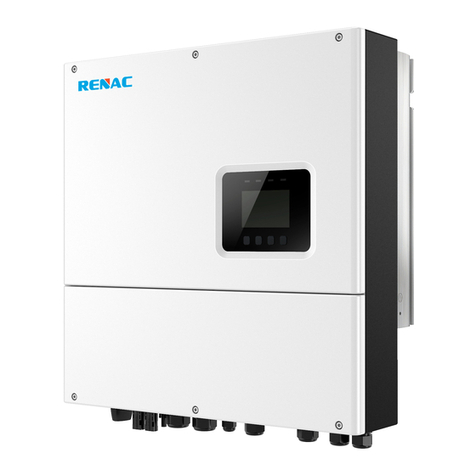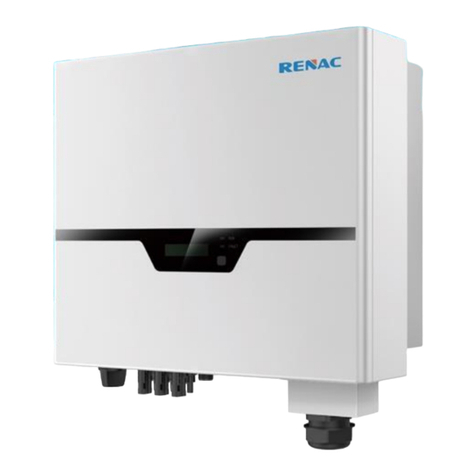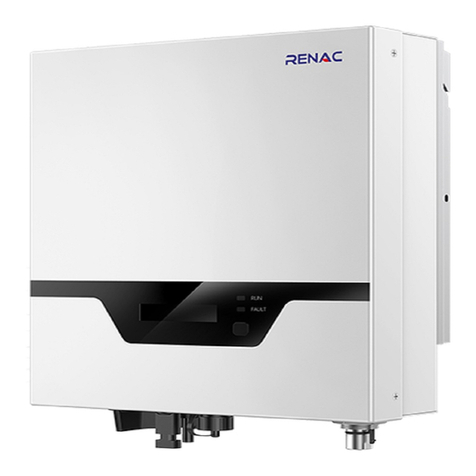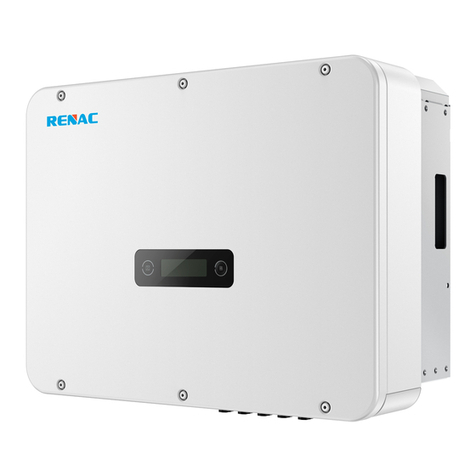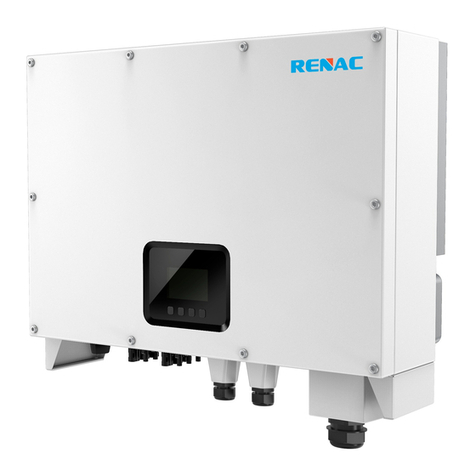
A1-HV Series User Manual4 5A1-HV Series User Manual
2.3 Explanation of symbols
This section gives an explanation of all the symbols shown on the type label.
Symbols on the Type Label
CE mark. The inverter complies with the requirements of the applicable CE
guidelines.
TUV mark.
Danger of high voltages.
Danger to life due to high voltages in the inverter!
Warning! Metal parts of the batteries are always under voltage. Do
notshort-circuit the batteries! ln case of a short-circuit, may flow very
highcurrents and cause burns. By Touching conductive parts can causecar-
diac arrhythmia and shock.
Danger.
Risk of electric shock!
Do not disconnect or disassemble by untrained personnel.
Do not short circuit.
Beware of hot surface.
The inverter can become hot during operation. Avoid contact during opera-
tion.
Symbol Explanation
DANGER!
◆PV strings will produce electrical power when exposed to sunlight and
can cause a lethal voltage and an electric shock.
◆Only qualified personnel can perform the wiring of the PV panels.
◆Do not open the enclosure when the inverter is running. Unauthorized
opening will void warranty and warranty claims and in most cases termi-
nate the operating license.
◆When the enclosure lid is removed, live components can be touched
which can result in death or serious injury due to electric shock.
◆Operating a damaged inverter can lead to hazardous situations that can
result in death or serious injuries due to electric shock.
◆Batteries deliver electric power, resulting in burns or a fire hazard when
they are short circuited, or wrongly installed.
◆Lethal voltages are present at the battery terminals and cables
connecting to the inverter. Severe injuries or death may occur if the
cables and terminals in the inverter are touched.
◆PV negative (PV-) and battery negative (BAT-) on inverter side is not
grounded as default design. Connecting PV- or BAT- to EARTH are strictly
forbidden.
◆Danger to life due to electric shock when live components or DC cables
are touched.
The DC cables connected to an inverter may be live.Touching live DC
cables results in death or serious injury due to electric shock. Disconnect
the battery system and inverter from voltage sources and make sure it
cannot be reconnected before working on the device. Do not touch
non-insulated parts or cables. Do not remove the terminal block with the
connected DC conductors from the slot under load.
Wear suitable personal protective equipment for all work on the battery
system.
observe all safety information of the inverter.
WARNING!
◆Do not disconnect PV connectors, AC connector or battery connectors
while the inverter is running. De-energize from all multiple power sourc-
es. Wait 5 minutes for the internal capacitors to discharge. Verify that
there is no voltage or current before disconnecting any connectors.
Use personal protective equipment, including rubber gloves and protetive
boots during the installation or maintenance.
◆Battery Module Leakage
lf the battery modules leak electrolytes,contact with the leaking liquid or
gas should be avoided.The electrolyte is corrosive,and the contact may
cause skin irritation and chemical burns.If one is exposed to the leaked
substance,do these actions:
lnhalation: Evacuate the contaminated area, and seek medical help
immediately.
Eye contact: Rinse eyes with flowing water for 15 minutes and seek
medical help immediately.
Skin contact:Wash the affected area thoroughly with soap and water and
seek medical help immediately.
Ingestion: Induce vomiting and seek medical help immediately .
◆The battery modules and its components should be protected from
damage when transporting and handling.
Do not impact, pull,drag, or step on the battery modules.
Do not insert unrelated objects into any part of the battery modules.
Do not throw the battery module into a fire.
Do not soak the battery modules in water or seawater.
Do not expose to strong oxidizers.
Do not short circuit the battery modules.
The battery modules cannot be stored at high temperatures(more than
50°C).
The battery modules cannot be stored directly under the sun.
The battery modules cannot be stored in a high humidity environment.
Do not use the battery modules if it is defective, or appears cracked,
broken or otherwise damaged,or fails to operate.
Do not attempt to open,disassemble,repair, tamper with,or modify the
battery modules.The battery modules are not user-serviceable.
Do not use cleaning solvents to clean the battery modules
CAUTION!
Do not touch any hot parts (such as the heat sink) during operation, The
temperature of inverter surface might exceed 60℃ during working
◆Risk of injury due to weight of the battery module
Ilnjuries may result if the battery module is lifted incorrectly or dropped-
while being transported or installed.
· Transport and lift the battery module carefully.Take the weight of the
battery module into account.
· Wear suitable personal protective equipment for all work on thebattery
system.
◆If the battery is not installed within one month after receiving thebat-
tery,
the battery must be charged till the SOCis more than 50% for maintains.
CAUTION!
◆Electrical installation and maintenance must be carried out by compe-
tent electricians according to local regulations.
◆Do not open inverter cover or change any components without RENAC
Power’s authorization, otherwise the warranty commitment for the
inverter will be invalid.
◆Usage and operation of the inverter must follow instructions in this user
manual, otherwise the protection design might be useless and warranty
for the inverter will be invalid.
NOTE!
◆Electrical installation and maintenance must be carried out by compe-
tent electricians according to local regulations.
The inverter built-in RCMU will exclude possibility of DC residual current
to 6mA, thus in the system an external RCD (type A) can be used(≥30mA).
NOTICE
